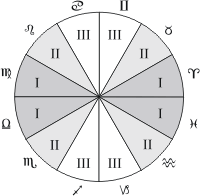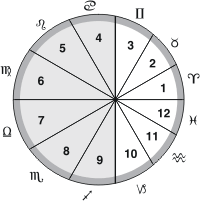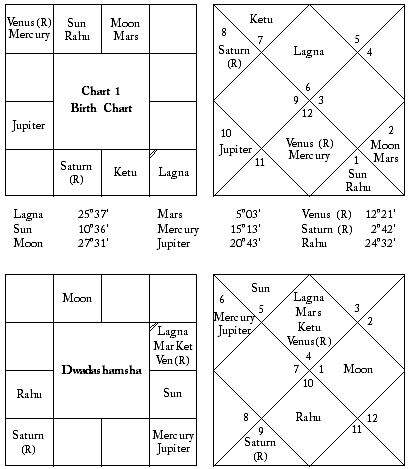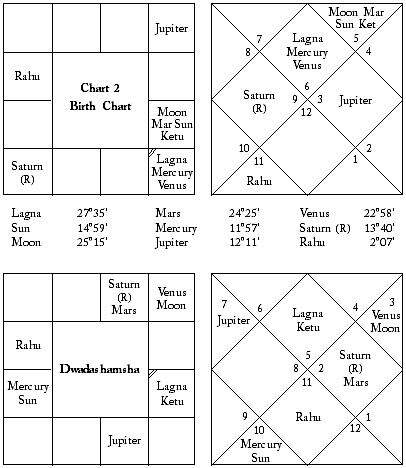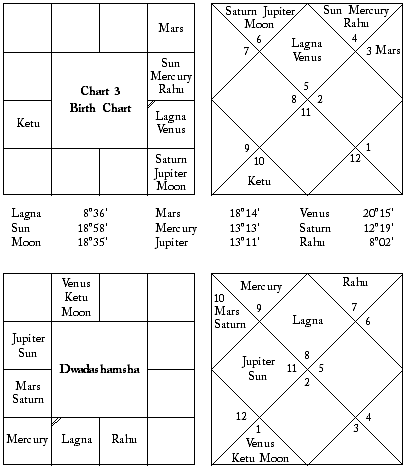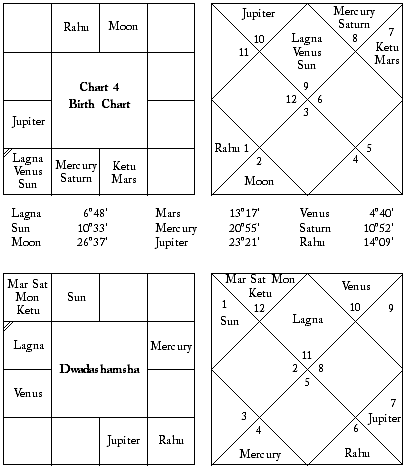Houses And Planets
The zodiac is divided into 12 signs and each sign has one house. So the whole life has been divided and contained in 12 houses which is explained as follows:
Signification of Houses
1st House: This is called Ascendant or Lagna, its lord is called Lagnesh. This house signifies life, longevity, self, health, nature and appearance of native. Complexion, vitality, sorrows, gains and profits to younger brothers and his friends. It governs head and face.
2nd House: This house indicates inflow of finances, bank position, right eye, family, early age or boyhood, speech, sanyas, servants and friends. Self earned wealth, loss or damage, worldly possessions, jewellery, grandfather and mother. It also denotes family, eyesight, understanding with family members, inheritance, law suits, throat, right eye, domestic comforts in general.
3rd House: It denotes younger brothers and sisters and their relations. It signifies courage, intelligence, education up to Higher Secondary level, taste for writing, ornaments, clothes, short journeys. Signing contracts and documents etc. Body parts are arms, right ear, shoulders, sports etc.
4rh House: This house signifies mother, property, conveyance, domestic surroundings and happiness. Old age environments, private affairs, public, inheritance, false allegations, agriculture land and its produce. It represents breasts, chest, lung, stomach, elbow joints etc.
5th House: Children, speculation, intellectual status and luck are gauged from this house. Pleasure, love affairs, lady love, legal or illegal amusements, kidnap, rape etc. are also checked. Belly, heart, liver, spleen are the body covered by this house.
6th House: This house is responsible for enemies,, health, service, servants, uncle, aunts and relations on father’s side. Food, subordinates, debts, obstacles in life, mental worries, theft and calamity etc. The body parts denoted are kidney, large intestine, uterus and anus.
7th House: Matters regarding wife, husband, partnership, external sex organs, conjugal happiness are checked from 7th house. This house also denotes marriage, married life, love, contracts, litigations, divorce, honour and reputation in foreign country. Body parts are private parts, uterus, glands etc.
8th House: Diseases, death finances through unfair means, internal sex organs, longevity, mental pain, obstacles, dowry of wife, gain from in-laws, mode of death, imprisonment, worries and privations are checked from 8th house. It indicates body parts as scrotum, pelvis, seminal vesicles, external genetalia, etc.
9th House: This house indicates religion,luck,father , foreign travel, publicity, preceptor, higher education, learnings, writing books, also faith, wisdom, prosperity, powers of foresight, religious institutions, providential help, etc. Hips, thighs are body parts.
10th House: This important house indicates father, profession, status in life, activities outside house, pleasures, honour, power and authority, Government favour, trade, business, command, honour, occupation, adopted son. All questions regarding worldly activities and moral responsibilities. Body parts are knees, joints, bones, hairs and back.
11th House: It accounts for accumulated wealth, elder brothers and sisters and relations with them. Friends, fluctuating money gains, club or social activities, emotional attachments, love affairs and friends, honour, social success etc. Body parts are legs, left ear, ankle etc.
12th House: It signifies private enemies, pleasures of beds, law suits, imprisonments, secret works, moksha, hospitalisation, conjugal relations with opposite sex other than legitimate. Sorrows, debts, lost goods etc. are judged. Body parts are feet, left eye, teeth etc.
Planet Lord of house
Sun Leo
Moon Cancer
Mars Aries& Sagitarus
Mercury Virgo &Gemini
Jupiter Sagittarius&Pises
Venus Libra& taurus
Saturn Aquarius&capricon
Rahu or kethu havenot own any house but behave like the which planet that own his house and planet which joined with Rahu or Kethu
Planet Moolatrikona Own house high power house low power house
Sun Upto 20 deg in Leo Last 10 deg in Leo Aries( 0-10dec) Libra
Moon From 3 to 30 deg in Taurus Cancer Tarurs(0-3) Sagitarus
Mars Upto 12 deg in Aries Rest of Aries& Sagitarus Capricon(0-28) Cancer
Mercury From 15 to 20 deg in Virgo Virgo &Gemini Virgo(0-15) Pises
Jupiter First 10 deg in Sagittarius Rest of Sagittarius&Pises Cancer Capricon
Venus First 5 deg in Libra Rest of Libra& taurus Pises Virgo
Saturn Upto 20 deg in Aquarius Last 10 deg in Aquarius&capricon Libra Aries
Planets and its Significations
(1)The soul (2)power (3)Father (4)fortress (5) good strength (6) heat (7)splendour (8)fire (9)worship of Siva (10)courage (11)thorned trees (12)being in royal favour (13)bitterness (14)old age (15)cattle (16)wickedness (17)land (18)father (19)taste (20)self-realisation (21)skyward look (22)one born of a timid woman (23)world of mortals (24)square (25)bone (26)valour (27)grass (28)the belly (29)strenuous effort (30)forest (31)half a year (32)eye (33)wandering over the mountains (34)quadruped (35)king (36)travelling (37)dealing (38)bite (39)scorch (40)circular shape
(1)Mother (2)flower (3)good perfune (40going to a fortress (5)disease (6)Brahmin (7)idleness (8)Phlegmatic humour (9)epilepsy (10)enlargement of the spleen (11)mental disposition (12)heart (13)woman (14)virtue or vice (15)sourness (16)sleep (17)happiness (18)any thing like water (19)silver (20)thick sugarcane (21)typhoid (22)travel (23)well (24)tank (25)mother (26)impartiality (27)mid-day (28)pearls (29) consumption (30)whiteness (31)waistband (32)bell-metal (33)salt (34)short stature (35)mind (36)ability (37)pond (38)diamond (39)winter season (40) a break of 48 minutes
(1) SPORTS (2)land (3)strength (4)carrying arms for the battle (5)Kingship (6)loss of verility (7)thief (8)battle (9)hostility (10)enemy(11)generosity (12)love for deep red colour things ((13)owning a garden(14)sound of a trumpet (15) affection(16)quadruped (17)king (18)fool (19)anger (20)going to a foreign country (21)firmness (22)supporter (23)fire (24)controversy (25)bile (26)heat (27)wound (28)service under a ruler (29)day (30)sky (31)seeing (32)shortness (33)disease (34)fame (35)tin (36)sword (37)lance or spear (38)minister (39)fracture of a limb (40)jewel
(1)education (2)‘horses (3)treasury (4)mathematics (5)wisdom (6)speech(7)Brahmin (8)infantry (9)writing (10)new garment(11)palatial building (12)green colour (13)sculprure (14)astrology (15)pilgrimage to holy places(16)wise lectures (17)temple (18)trading (19)best ornaments (20)courteous speech(21)Vedanta philosophy (22)maternal-grand-father (23)bad dreams (24eunuch (25)facing North (26)skin (27)wet (28)bell-metal (29)renunciation (30)Ritu (31)a beautiful house (32)doctor (33)neck (34)influencing through recitation of mantras (35)child (36)crooked look(37)heaven (38)modesty (39)paternal relation (40)fear
(1)SON OR DAUGHTER (2)Guru (3)one’s duty(4)Chariot (5)cow (6)infantry (7)savings(8)Meemamsa (9)treasure (10)horse (11)curd, etc. (12)large body (13)Valour (14)reputation (15)logic (16)astrology (17)son (18)grandson (19)dropsy(20)wealth of elephants (21)philosophy (22)great grand-fathers (23)palacial house (24)gems (25)eldest brother (26)grand father (27)Lord Indra (28)cold season(29)wrath (30)jewel (31)merchant (32)physical health (33)a beautiful mansion (34)royal honour (35)thigh (36)Gods (37)penance (38)charity(39)religious duty (40)helping others
(1)WIFE OR LOVER (2)a good chowrie (3)garment (4)marriage (5)income (6) a biped (7)woman (8)Brahmin (9)Subha (10)Whiteness (11)wife (12)sexual happiness (13)short (14)sour (15)flower (16)command (17)fame (18)Youthful vigour (19)Vehicle(20)silver(21)South-East quarter (22)saltish(23)ogling (24)scratching (25)half a month (26)the quality of passion (27)strong (28)pearl (29)Yajur Veda (30) Vaisya (31)beauty (32)buying and selling (33)love-making (34)watery resort (35)elephant (36)horse (37)variegated colour (38)poetry (39)dancing (40)middle age
(1)laziness, etc.(2)obstruction(3)OLDER PEOPLE(4)elephant(5)skin(6)gain7)proof or tness(8)distress(9)sickness(10)misunderstanding(11)misery(12)death(13)happiness through a woman(14)maid servant(15)asses and mules(16)outcaste (17)one with disfigured limbs(18)haunting woods(19)handsome look(20)gift(21)a lord(22)a portion of life(23)eunuch(24)one born of the lowest caste(25)birds(26)the three sacred fires(27)a servile duty(28)unrighteous conduct(29)one without manliness(30)telling lies(31)long lasting(32)wind (33)old age(34)tendons and muscles(35)strong at the end of the day(36) Sisira Ritu or winter(37)great-anger(38)exertion(39)born of a very low mother (40)bastard
Rahu:
(1) Umbrella (2)Chowrie (3)kingdom (4)gathering (5)fellacious argument (6)hurting byspeech(7)downcast(8)wicked woman(9)decorated vehicle(10)an irreligious man(11)gambling(12)strong at twilight(13)intriguing with a wicked woman(14)going abroad (15)impurity(16)bone(17)enlargement of spleen(18)falsehood(19)downward look(20)perplexity(21)emerald(22)facing the Southern quarter(23)shelter of outcaste or low people(24painfulswelling(25)a big forest(26)wandering in rugged places(27)mountain(28)pain(29)staying outside(30)tending towards South-West(31)wind(32)phlegm(33)sorrow(34)serpent(35)night breeze(36)sharp(37)long(38)reptile(39)reading of dreams(40)travel
Ketu:
(1)Worship of God Chandeesa, God Ganesha and many other gods(2)doctor(3)dog(4)a cook(5)vulture(6)salvation(7)all kinds of wealth(8)consumption (9)pain(10)fever(11)bathing in the Holy Ganges(12)great penance(13)wind(14)a Hunter(15)friendship(16)conferring of prosperity(17)stone(18)wound(19)witchcraft(20)inconstancy(21)knowledge of Brahma(22)belly(23)eye-sore(24)stupidity(25)thorn(26)deer(27)knowledge(28)observingsilence as a fast (29)philosophy(30)all sorts of luxuries(31)luck(32)trouble from enemies(33)loss of appetite(34)indifference to the world (35)paternal grandfather(36)hunger(37)severe stomachache(38)boil sand the like skin troubles(39)revoking the orders of arrest and (40)the association of Sudra.
Apart from the above, planets are classified as favourable and adverse based on births under the 12 different ascendants. These are narrated below:
Aries: Pure benefics are Jupiter and the Sun. Malefics are Saturn, Mercury and Venus. Venus is the prime killer. Jupiter will give inauspicious results if he is conjunct an adverse planet. However when with Saturn he is not wholly adverse.
Taurus: Saturn and the Sun are benefics and can cause Rajayoga. Jupiter, Venus and Moon are not auspicious and may prove death inflicting palnets. Mercury can cause some Yoga.
Gemini: Venus is the only benefic. Mars, Sun and Jupiter are inauspicious. Saturn and Jupiter together behave in the same manner as for Aries birth. The Moon is the prime killer. (Some replace the Moon with Saturn).
Cancer: Mercury and Venus are malefics. Mars, Jupiter and Moon are auspicious. Mars is a supreme Rajayoga karaka. Saturn is capable of inflicting death and is Maraka lord.
Leo: Inauspicious planets are Mercury, Venus and Saturn. Mars, Jupiter and the Sun are benefics. Jupiter with Venus cannot give fully benefic results. Saturn is Maraka and the Moon’s effects depend on her association.
Virgo: Mars, Jupiter and the Moon are adverse. Venus is the only favourable planet. Mars is a Maraka lord.
Libra: Saturn and Mercury prove auspicious. The moon and Mercury and capable of conferring great benefits and position. Jupiter, the Sun and Mars are inauspicious. Mars is a Maraka lord. Venus gives balanced results for this ascendant, if unafflicted by others.
Scorpio: Jupiter, as well as the Moon are benefics, the Moon and the Sun are Rajayoga planets. Mercury and Venus give inauspicious effects. Saturn gives mixed results . Jupiter if illrelated will become a Maraka. Mars is of mixed nature.
Sagittarius: Venus is adverse. Mercury, Mars and the Sun are yogakaraakas. If the Sun joins Mercury he will also become a Rajayoga Karaka. Saturn is a killer apart from Venus.
Capricorn: Mars, Jupiter and the Moon are inauspicious. Venus and Mercury are benefical. Saturn is not a Maraka lord, while Mars etc. may prove as killers.
Aquarius: Jupiter, Moon and Mars produce adverse results. Venus and Saturn are exclusively benefics. Mars and Jupiter are killers. If others are related to one of these two, they will also become adverse.
Pisces: Saturn, Venus, Mercurry and the Sun are classified as unfavourable. Mars and Moon are auspicious. Mars and Jupiter are Yogakarakas. Saturn and Mercury are Marakas.
